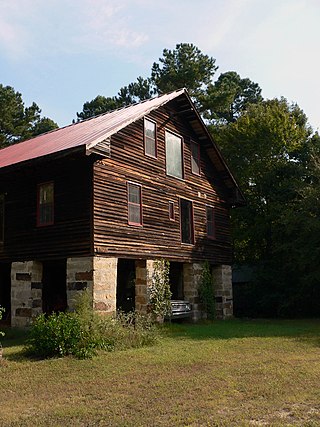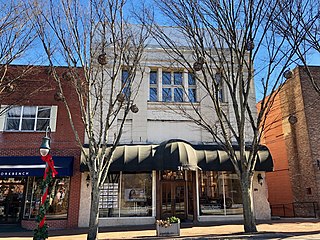
Oxford is a town in Granville County, North Carolina, United States, with a population of 8,628 as of the 2020 census. It is the county seat of Granville County.
Aurelian Springs is an unincorporated community in Halifax County, North Carolina, United States. It is part of the Roanoke Rapids, North Carolina Micropolitan Statistical Area.

Middleton Place is a plantation in Dorchester County, along the banks of the Ashley River west of the Ashley and about 15 miles (24 km) northwest of downtown Charleston, in the U.S. state of South Carolina. Built in several phases during the 18th and 19th centuries, the plantation was the primary residence of several generations of the Middleton family, many of whom played prominent roles in the colonial and antebellum history of South Carolina. The plantation, now a National Historic Landmark District, is used as a museum, and is home to the oldest landscaped gardens in the United States.

Isle au Haut Light, also called Robinson Point Light, is a lighthouse located at Robinson Point in Isle au Haut, Maine. The lighthouse was established in 1907.

Little River Light is a lighthouse on an island at the mouth of the Little River, in Cutler, Maine. A light station was first established at this site in 1846, and the present structure was built in 1876. It is one of the only iron lighthouses in the state, and was listed on the National Register of Historic Places as Little River Light Station on March 14, 1988. The light station is now owned by the American Lighthouse Foundation, which offers overnight stays in the keeper's house, and occasional tours of the property.

Petit Manan Light is a lighthouse on Petit Manan Island, Maine. The island is at the end of a series of ledges extending out from Petit Manan Point, between Dyer Bay and Pigeon Hill Bay, that projects into the Gulf of Maine.

The Walnut Hill Plantation cotton gin house was built in the mid to late 1840s by Alonzo T. Mial, a prominent planter and commission merchant in 19th century North Carolina. It is one of a few surviving cotton gin houses in the state, and is likely the only one to have retained the majority of its original ginning equipment.
Thomas Person (1733–1800) was an American politician, Anti-Federalist organizer, and brigadier general in command of the Hillsborough District Brigade of the North Carolina militia during the American Revolution.

Erected in 1930, the Sugar House Monument has long stood as a testament to the hard work of early Salt Lake pioneers making the valley sustainable.

The Hidden Valley Rockshelter (44-BA-31) is a significant archaeological site located near the community of Warm Springs in Bath County, Virginia, United States. A large rockshelter located near the Jackson River, it has been occupied by humans for thousands of years, and it has been named a historic site.

Richmond Town Hall is the town hall of Richmond, New Hampshire, United States. Built in 1780, and originally used for both civic and religious purposes, it is one of the oldest meeting houses in the state. The building was listed on the National Register of Historic Places in 1979.

The Andrews-Duncan House is a historic building located at 407 North Blount Street in Raleigh, North Carolina, United States. Built in 1874 for a prominent businessman, the Italianate style home was designed by architect George S. H. Appleget. The house was added to the National Register of Historic Places (NRHP) in 1972 and is currently owned by the state government. A large tree named after a presidential candidate once stood behind the house and is commemorated with a historical marker.

The Former Citizens Bank and Trust Company Building is a historic bank building located at Waynesville, Haywood County, North Carolina. It was built in 1921, and is a two-story, brick and marble front rectangular building in the Classical Revival style. It measures 76 feet by 31 feet and features a tall parapet faced with marble block that rises above the cornice. The bank ceased operation in 1932, and the building has since housed retail businesses.

Hood-Strickland House, also known as the T. R. Hood House, is a historic home located at Smithfield, Johnston County, North Carolina. It was built between 1887 and 1889, and is a two-story, three bay, "T"-shaped Italianate style frame dwelling. It has a tall clipped gable roof, bracketed cornice, three sided bays, tall corbelled chimneys, segmental arched windows, and a decorative porch.

Boyette Slave House is a historic home located near Kenly, Johnston County, North Carolina. It is a small one-room log dwelling. It is built of hewn and pit-sawn plans and features a gable end stick and mud chimney. The building measures 16 feet by 12 feet and 8 feet tall. Between 1890 and 1910 it was reused as a schoolhouse.

Hayes-Byrum Store and House is a historic home, store, and national historic district located near Charlotte, Mecklenburg County, North Carolina. The store was built about 1890, and is a one-story, gable front, brick building. It measures 35 feet by 60 feet and has a wide, arched entrance with wooden double doors. North of the store is the two story, asymmetrical, Queen Anne style frame dwelling built about 1900. It has a cross-gable roof and features a cutaway bay. The store is considered the oldest surviving commercial building in rural Mecklenburg County.

The Lakeside Ballroom, also known as the Lakeside Pavilion, is a historic building located in Guttenberg, Iowa, United States. It is located next to the Mississippi River near a backwater known as Bussey Lake. The first part of the building was completed in 1927 by local contractor Louis Schroeder for $17,000. William (Bill) Kann Sr. had the facility built as the Lakeside Pavilion, and it was operated by two of his sons, Edmund and William Jr. They sold the building in 1935 and it was expanded and converted into a ballroom. Many local and national music acts performed at Lakeside, including: Jesse Stone, Jimmy Wade, Wayne King and their orchestras.

The Keweenaw Waterway Lower Entrance Light, also known as the Portage Entry Light, is a lighthouse located at the south end of breakwater at mouth of the Portage River in Torch Lake Township. It was listed on the National Register of Historic Places in 2014.

The Keweenaw Waterway Upper Entrance Light is a lighthouse located at the north end of the Portage River in McLain State Park in Hancock Township, Michigan. It was listed on the National Register of Historic Places in 2014.

The Presque Isle Harbor Breakwater Light is a lighthouse located on the breakwater at northeast side of Presque Isle Harbor in Marquette, Michigan. It was listed on the National Register of Historic Places in 2016.





















